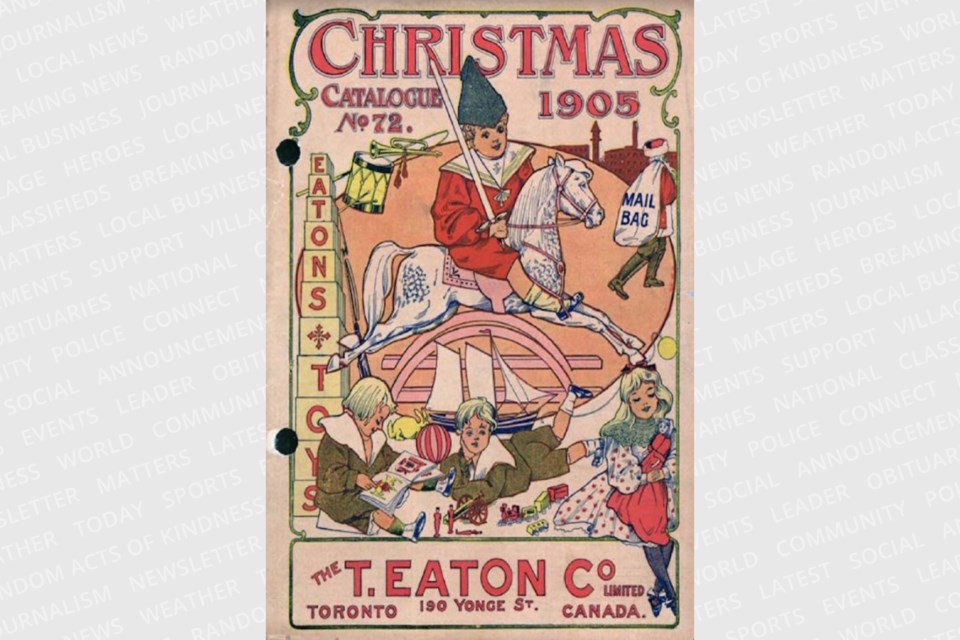Imagine you’re a child waking up on Christmas morning before the rooster crows, and even though the house is cold because your parents haven’t got the fire going yet, you’re giddy with excitement because you know there’s going to be a present in your stocking.
It might be a doll, or a jack-knife, or a boomerang – or an orange!
In the early days of Elora and Fergus, and other pioneer communities in Wellington County, the children’s treasures of Christmas morning weren’t at all like the goodies kids find under the tree today.
Life was tough for most people. The majority of those hard-working residents of the countryside and the little towns were immigrants or just a generation removed from forebears who were newcomers to Canada. Few households had money to spare for things like toys. The presents that came out of Santa’s sack were usually simple and inexpensive.
In a collection of reminiscences called Older Voices Among Us, edited by Alvin Koop and Shelia McMurrich Koop (Boston Mills Press, 1981), Mrs. Gordon Cleghorn recalled what a treat it was to find an orange in her stocking on Christmas morning, because, “Such a thing as eating an orange all by yourself, that was unthinkable. You shared your orange. There were oranges at Christmastime but there weren’t oranges the rest of the year.”
Mrs. Cleghorn also remembered that Christmas Eve was a special occasion because there would be a trip to Guelph by horse and cutter. For most kids in rural areas, excursions to the city at any time of the year were an adventure, but they were especially rare in the winter.
Even after the coming of the railroad they could be only an occasional event for many families, because taking the train cost money.
Kids from late 19th and early 20th century Elora and Fergus wouldn’t recognize most of the toys Santa brings children today. There was no such thing as plastic, batteries or super hero merchandise. No Pokémon cards, Lego sets or games featuring Minions, Smurfs or Muppets. No doll even remotely resembled Barbie.
However, parents could give a child the parts – including heads, wigs and clothes – with which to assemble her own doll.
The boomerang was a popular toy around the turn of the 20th century. The weapon invented by Indigenous Australian hunters was seen as an exotic plaything for North American kids.
“As fascinating as the kite,” said an article in the Toronto Globe, which then gave a detailed explanation on how to use a boomerang.
In that same period, when Canadian troops were fighting in the Boer War (now called the South African War), military toys were in demand, although a Globe editorialist wrote that this was due more to “amuse … the parents” than the little boys to whom they were given. Toy guns, cannons, soldiers, swords and bayonets were under trees on Christmas morning.
The Eaton’s catalogue, popularly known as the Homesteader’s Bible, could be found in many small town and rural homes – and outhouses, where it served a dual purpose.
It allowed residents to purchase department store goods that might not be available with small town retailers. Of course, that included toys. Browsing through the catalogue in the weeks leading up to Christmas was one of the exciting activities of the season, even if the young browsers could only dream.
There were no video games in that book, but it did have chess, checkers and that classic game alleged to have been invented in an Ontario farmhouse, Crokinole. There was an assortment of toy wagons and carts to choose from, as well as various sizes of tricycles called velocipedes. The catalogue advised parents to measure the inside of the child’s leg before ordering a velocipede.
Sleds had always been popular Christmas presents, but in 1890 a new model called the Fire Fly had a special feature: it was the first kid’s sled that could be steered. No more crashing into trees – or so parents hoped.
A few years later an improved and more affordable sled appeared; the Flexible Flyer. The advertising slogan went, “It takes from father all signs of the blues, For the self-steering sled is a saver of shoes.”
The catalogue offered hockey skate blades, with a choice of Starr, Micmac and Chebucto brands.
There were also Beaver and Fisher skate blades for girls and women.
For all types of skate blades, the boots were sold separately.
For kids with an aptitude (or not) for music there were drums, flutes, tambourines and an instrument called a “blow accordion.” Several brands of mouth organ were featured, including one with “Capetown to Pretoria” engraved on it along with images of British Boer War leaders Lord Frederick Roberts and Lord Horatio Kitchener.
The early 1900s saw the introduction of Crayola crayons, an inexpensive American product for kids whose families couldn’t afford the much more costly artists’ crayons imported from France.
For boys (and their dads) in more well-to-do families there was the new Lionel electric train. Accessories included pellets to make the locomotive puff out smoke. They were made from ammonium nitrate, which was potentially explosive.
Another new arrival was the Teddy bear, named in honour of American President Theodore Roosevelt who, on a hunting trip, had refused to shoot a bear his aides had trapped and tied to a tree as an easy target for him. Roosevelt considered it unsporting and told his aides to let the bear go.
The Teddy bear would become the most successful stuffed toy in history, found under Christmas trees in millions of homes, including those in Fergus and Elora, right up to the present day.
Merry Christmas and Happy New Year to all.



